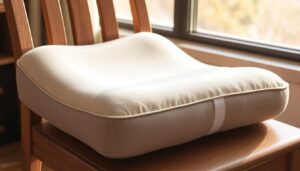If you’re a new mom, you might know about wrist pain from bottle feeding. Pregnancy hormones can cause swelling and pressure in your wrist. This can lead to tingling, numbness, and pain.
But, don’t let this stop you from enjoying parenting. There are ways to ease wrist pain while bottle feeding. Using ergonomic tips can help and make bonding with your baby better.
Key Takeaways
- Discover wrist pain relief bottle feeding techniques that protect your wrist health.
- Understand how pregnancy-related changes can contribute to wrist discomfort during bottle feeding.
- Explore ergonomic tips that promote a comfortable and pain-free feeding experience.
- Learn about the importance of proper posture and support to prevent wrist strain.
- Gain insight into how repetitive motions can exacerbate wrist issues and ways to mitigate them.
Understanding the Causes of Wrist Pain from Bottle Feeding
Feeding your baby shouldn’t hurt your wrists. But, many parents face wrist pain and discomfort from bottle feeding. Knowing why can help you find ways to feel better.
Swelling and Edema during Pregnancy
Wrist pain from bottle feeding often starts during pregnancy. Swelling and edema put extra pressure on your wrist. This can cause tingling, numbness, and pain in your fingers, leading to carpal tunnel syndrome.
Repetitive Motions and Prolonged Wrist Bending
After pregnancy, new tasks like bottle washing can hurt your wrists. Holding or feeding your baby for a long time also puts stress on your wrist joints.
Identifying Symptoms of Carpal Tunnel and Tendonitis
| Condition | Common Symptoms | Related to Bottle Feeding |
|---|---|---|
| Carpal Tunnel Syndrome | Tingling, numbness, pain especially in the thumb, index, and middle fingers | Yes |
| Tendonitis (Mommy Wrist) | Pain and tenderness at the base of the thumb, exacerbated by movement | Often |
Spotting these symptoms early can help you tackle wrist pain from bottle feeding. It lets you find the right treatment or change your feeding ways. Remember, facing these health issues is a step towards better health and comfortable parenting.
Preventing Wrist Pain: Effective Ergonomic Practices
To keep you comfortable while feeding your baby, it’s key to think about wrist ergonomics. The right posture and positioning can help avoid wrist pain from bottle feeding. This makes feeding time better for both you and your baby.
Choosing the Right Chair and Posture for Bottle Feeding
It’s important to find a chair that supports your back and arms for bottle feeding. A chair that supports you well keeps your body aligned and comfy. Try using a footstool to lift your feet a bit, which helps keep your posture right.
Proper Baby Positioning to Reduce Wrist Strain
Positioning your baby right is good for their comfort and yours. Hold your baby so their belly is against you. This helps them latch well and eases wrist pressure. Using the ‘football hold’ can also help spread out your baby’s weight.
Importance of Using Supportive Accessories like Nursing Pillows
Using nursing pillows can greatly help with wrist ergonomics while feeding. A nursing pillow takes some of your baby’s weight off your hands, easing wrist strain. For extra comfort, think about wearing a wrist brace to keep your wrists straight during and after feeding.
Wrist Pain from Bottle Feeding: Strategies for Pain Relief
If you’re feeling baby feeding wrist pain, you’re not alone. Many parents look for ways to ease wrist pain relief bottle feeding. Here are some strategies that might help.

First, try comfortable nursing positions to ease wrist strain. Make sure you’re seated well, with back support, before feeding. Holding your baby too high or low can hurt your wrist. Use pillows or supports to keep your baby at a good height without bending your wrist.
Wrist braces can also offer a lot of relief. They keep your wrist in a neutral position, preventing it from bending too much during feeding. Also, switching hands can give each wrist a break.
- Use ergonomic bottle designs that are easier to hold.
- Apply cold compresses after feeding to reduce inflammation.
- Get advice from a lactation consultant for personalized tips and strategies.
If these steps don’t help, see a healthcare professional. They might suggest physical therapy for more baby feeding wrist pain relief.
| Strategy | Description | Benefits |
|---|---|---|
| Ergonomic positioning | Using pillows to elevate baby to a comfortable feeding position. | Reduces wrist bending and strain. |
| Wrist braces | Supports wrist in a neutral alignment during feeds. | Prevents excessive motion and supports wrist health. |
| Professional consultation | Engaging with health experts for tailored advice. | Access to personalized strategies and potential therapy options. |
By taking these steps, you not only relieve wrist pain relief bottle feeding but also improve your feeding experience. Keeping your wrists comfortable lets you care for your baby better, with joy and ease.
Exercises and Therapies for Strengthening Wrist and Thumb
Bottle feeding can strain your wrists. To fight this, doing exercises and therapies to strengthen your wrist and thumb is key. These actions boost wrist ergonomics and hand health. Let’s look at some daily routines to ease pain and boost movement.

Elastic band stretching is a simple start. Use a rubber band to stretch your fingers and thumb. Place the band around your fingers and thumb, then stretch and return to start. This warms up your hand muscles and can be done many times a day.
Thumb lifting is another good exercise. Lift your thumb off a table with your other hand helping. This builds thumb and wrist strength, helping avoid wrist strain from feeding.
Wrist flexion and extension exercises are also helpful. Extend your arm with your palm down, then bend your wrist down. Hold, then bend your wrist up. These exercises keep your wrist moving well and ease tension from feeding.
When you get better at these exercises, add weights for more challenge. Small hand weights make these exercises harder, building muscle. This helps a lot with wrist issues from feeding your baby.
Doing these exercises regularly makes your wrists stronger and less painful. Remember, sticking with it is important to see results.
Nurturing Bottle Feeding Techniques to Minimize Discomfort
Using the right bottle feeding tips is key to keeping both you and your baby comfortable. By changing how you feed, you can ease wrist pain. This makes feeding time a joy for everyone.
Here are some strategies to try:
- Alternating Hands and Utilizing Various Holds: Switch the hand you hold the bottle with often. This spreads out the strain on your wrists. Try different holds like cradle, cross-cradle, and football to find what works best for you.
- Adjusting Feeding Frequency and Duration: Long feedings can hurt your wrists. Try shorter, more frequent feeds to ease the strain.
- Transitioning to Side-lying Feeding for Comfort: Side-lying feeding is a great alternative. It lets your arm rest naturally, reducing wrist strain.
By following these tips, you’ll feel more comfortable. You’ll also make feeding time a special bonding moment with your baby.
| Feeding Position | Benefits |
|---|---|
| Cradle Hold | Supports comfortable arm and wrist alignment, good for relaxed feedings. |
| Cross-Cradle Hold | Offers better control of the baby’s head and the bottle, ideal for newborns. |
| Football Hold | Reduces wrist strain, preferred after C-sections for comfort. |
| Side-lying Position | Minimizes wrist use, aligns with natural body posture for restful feeding. |
Conclusion
Wrist pain from bottle feeding is a complex issue. It involves changes in the body during pregnancy and the need for ergonomic practices and exercises. You now know how to spot symptoms of carpal tunnel and tendonitis, making motherhood easier.
Using ergonomic accessories and doing wrist exercises can help a lot. Changing how you bottle-feed can also reduce pain. These small changes can make feeding time a special moment of bonding.
The aim is for bottle feeding to be a joy for you and your baby, without pain. Knowing the best practices and using them can greatly help. Keep your well-being in mind as you parent, ensuring every feed is good for your baby and gentle on you.







